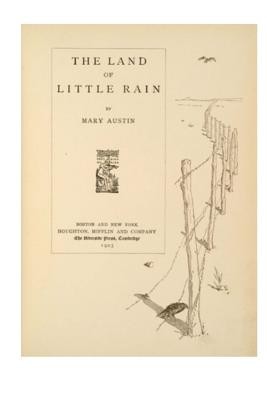
- We will send in 10–14 business days.
- Author: Mary Austin
- Publisher: CreateSpace Independent Publishing Platform
- Year: 2016
- Pages: 86
- ISBN-10: 1523684577
- ISBN-13: 9781523684571
- Format: 15.2 x 22.9 x 0.5 cm, softcover
- Language: English
- SAVE -10% with code: EXTRA
Reviews
Description
The Land of Little Rain
by Mary Austin
COMPLETE
The Land of Little Rain is a book written by American writer Mary Hunter Austin. First published in 1903, it contains a series of interrelated lyrical essays about the inhabitants of the American Southwest, both human and otherwise.
The Land of Little Rain has been published six times. The first publication was in 1903 by Houghton Mifflin. Subsequent publications include a 1950 abridged version with photographs by Ansel Adams (also by Houghton Mifflin), a 1974 illustrated version by E. Boyd Smith published by University of New Mexico Press, a 1988 edition with an introduction by Edward Abbey published as part of the Penguin Nature Library by Penguin Books, and a 1997 edition published with an introduction by Terry Tempest Williams, also published by Penguin Books, and a 2014 edition with photography by Mojave Desert photographer Walter Feller, publisher by Counterpoint Press.
The Land of Little Rain is characterized as both "local color" and non-fiction, scientific writing. It was written for an urban American audience unfamiliar with life in the Mojave desert. The book attempts to engage the reader by including direct, second person along with first and third person point of views. Common stereotypical images and ideas about the desert are presented and contrasted to the narrator's past experiences. Specific and intimate experiences with nature in the desert are reproduced in the present tense for the reader's benefit.
The language is elevated and formal but made more conversational with informal colloquial language and jargon of the Southwest. The long and involved sentences often link abstractions to concrete images and description of the desert. The descriptions are subjective and characterized by laudatory, critical, or satiric language. They are further colored by abundant use of metaphors, similes, and hyperbole.
- Author: Mary Austin
- Publisher: CreateSpace Independent Publishing Platform
- Year: 2016
- Pages: 86
- ISBN-10: 1523684577
- ISBN-13: 9781523684571
- Format: 15.2 x 22.9 x 0.5 cm, softcover
- Language: English English
The Land of Little Rain
by Mary Austin
COMPLETE
The Land of Little Rain is a book written by American writer Mary Hunter Austin. First published in 1903, it contains a series of interrelated lyrical essays about the inhabitants of the American Southwest, both human and otherwise.
The Land of Little Rain has been published six times. The first publication was in 1903 by Houghton Mifflin. Subsequent publications include a 1950 abridged version with photographs by Ansel Adams (also by Houghton Mifflin), a 1974 illustrated version by E. Boyd Smith published by University of New Mexico Press, a 1988 edition with an introduction by Edward Abbey published as part of the Penguin Nature Library by Penguin Books, and a 1997 edition published with an introduction by Terry Tempest Williams, also published by Penguin Books, and a 2014 edition with photography by Mojave Desert photographer Walter Feller, publisher by Counterpoint Press.
The Land of Little Rain is characterized as both "local color" and non-fiction, scientific writing. It was written for an urban American audience unfamiliar with life in the Mojave desert. The book attempts to engage the reader by including direct, second person along with first and third person point of views. Common stereotypical images and ideas about the desert are presented and contrasted to the narrator's past experiences. Specific and intimate experiences with nature in the desert are reproduced in the present tense for the reader's benefit.
The language is elevated and formal but made more conversational with informal colloquial language and jargon of the Southwest. The long and involved sentences often link abstractions to concrete images and description of the desert. The descriptions are subjective and characterized by laudatory, critical, or satiric language. They are further colored by abundant use of metaphors, similes, and hyperbole.


Reviews